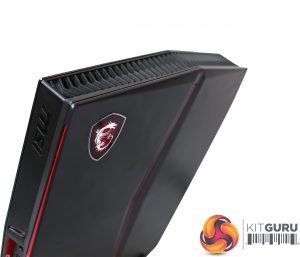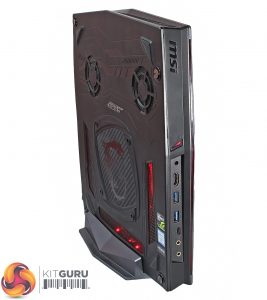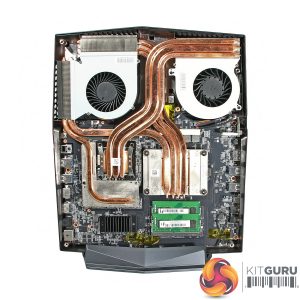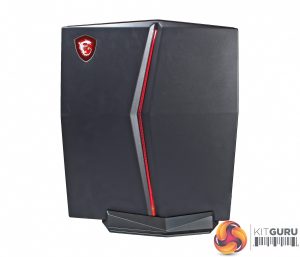The MSI Vortex G25 is truly tiny. It’s 331mm tall and 43mm wide, and it weighs 2.5kg. Those dimensions are barely bigger than most gaming laptops, and many notebooks actually weigh more than this machine – so there aren’t many desktops that are so easy to carry to LAN parties and friends’ houses.
The Vortex G25 is many times smaller than the average desktop, but it’s also tiny when compared to other small form-factor rigs. The recent Corsair One Elite weighs three times as much and is both taller and far wider. MSI’s own Trident 3 is larger, too: a couple of centimetres taller, twice as wide and half a kilo heavier.
This machine is tidy – and it looks good, too. One side has a slash in the plastic that lights up with RGB LEDs alongside MSI’s Dragon Gaming logo. The front on the machine has another band of red light and a recessed area for ports.
The other side panel has cooling vents, and the plastic used throughout is strong enough to withstand frequent transport. It’s certainly more discreet than the white MSI Trident machine, although the subtle Corsair One Elite is smarter still.
MSI has paired the Vortex’s solid design with a surprising amount of versatility. The system includes a 110mm-wide stand for vertical use, and rubber feet allow the Vortex to be stowed beneath a TV. The rear has a 100mm VESA mount, so the G25 can even be attached to the rear of a monitor – and completely out of sight.
MSI has been sensible with its port allocations, too. The front of the system has an HDMI port, two USB 3.0 connections and a USB 3.1 type-C connector – so it’s ideal for peripherals and VR headsets. At the rear you’ve got another HDMI jack, more USB connectivity and Gigabit Ethernet. There’s no DisplayPort and no bank of audio ports for connecting to beefier speaker rigs, but those are minor issues on such a tiny rig.
The G25’s rear panel also has a quartet of tool-free screws, which makes it easy to remove this side of the machine. Once that’s done, the Vortex’s secrets become clear. The G25 isn’t really much of a desktop at all – it’s a modified laptop motherboard packed inside a small case.
The board has been tweaked to work with a full-size desktop processor, and it retains the mobile graphics and SO-DIMM memory that we’d expect from this class of computer.
The CPU and GPU are cooled using low-profile cooling hardware that looks like it’s come straight out of a laptop – it’s all squat copper pipes and small fans.
There’s no room to add additional hardware inside this machine, but most of the major components can be accessed, which is handy for solving problems, upgrading the memory or keeping the fans clean. The storage is the only part that isn’t easy to reach.
 KitGuru KitGuru.net – Tech News | Hardware News | Hardware Reviews | IOS | Mobile | Gaming | Graphics Cards
KitGuru KitGuru.net – Tech News | Hardware News | Hardware Reviews | IOS | Mobile | Gaming | Graphics Cards




